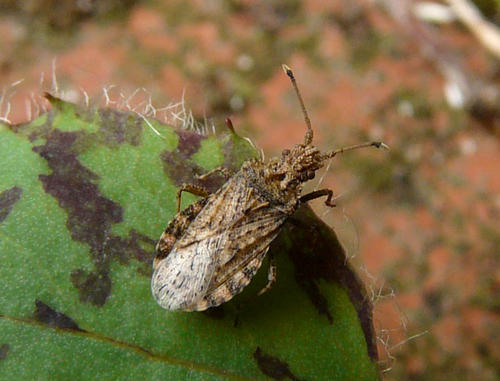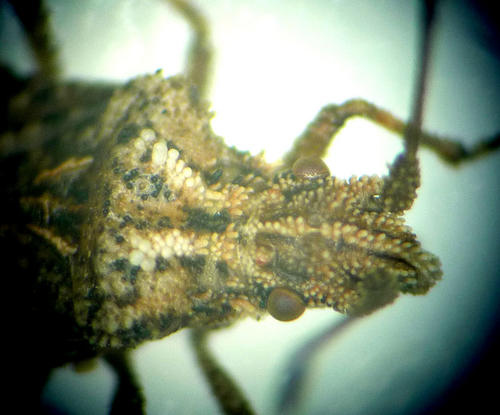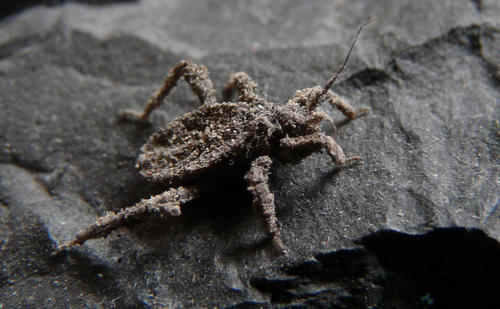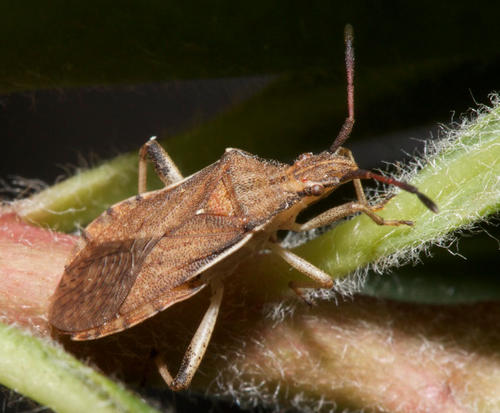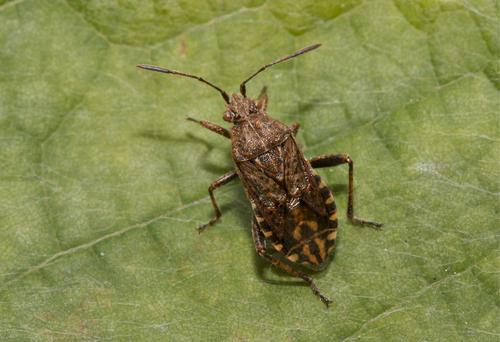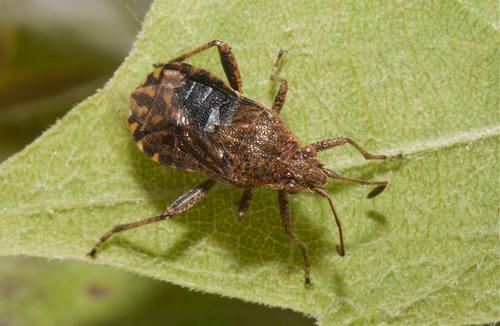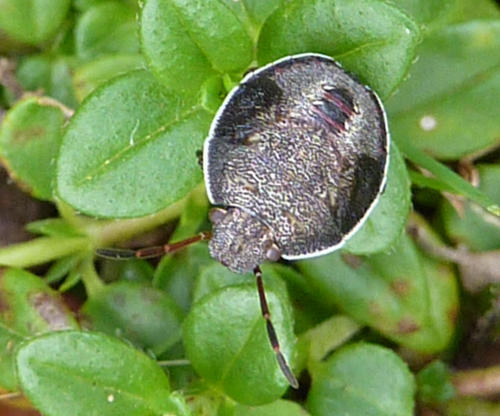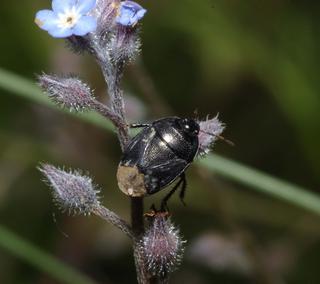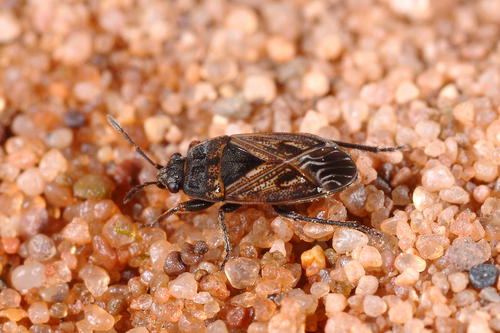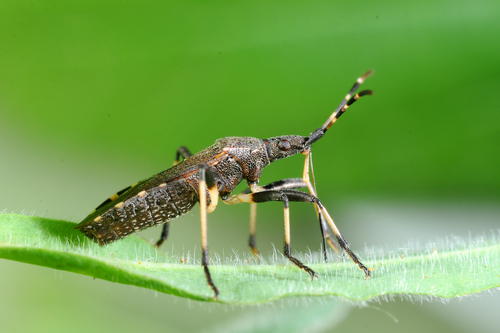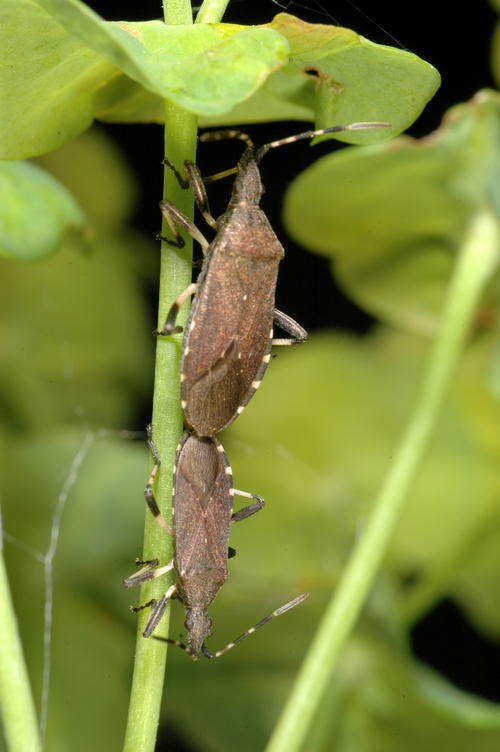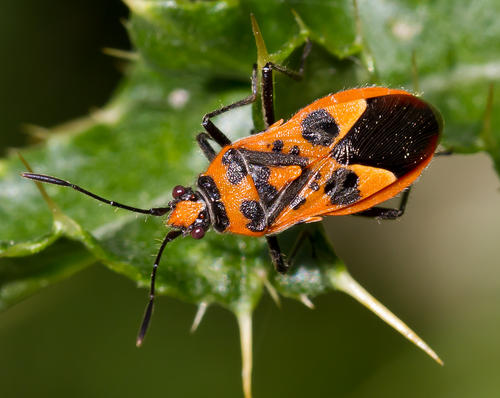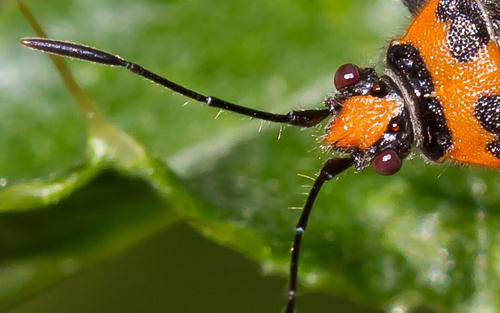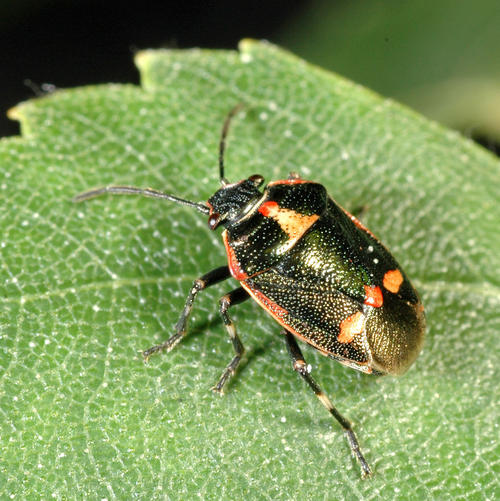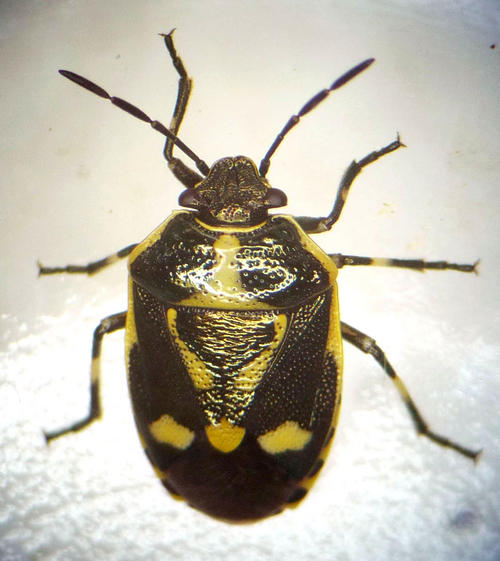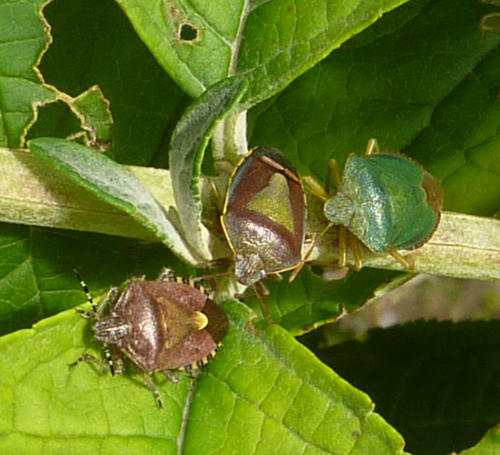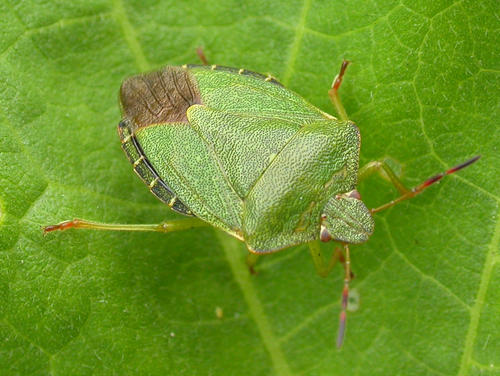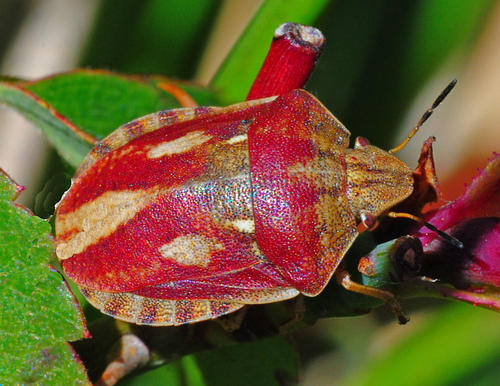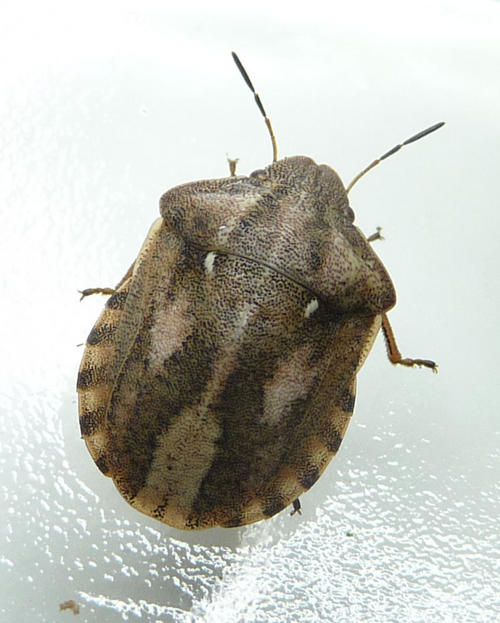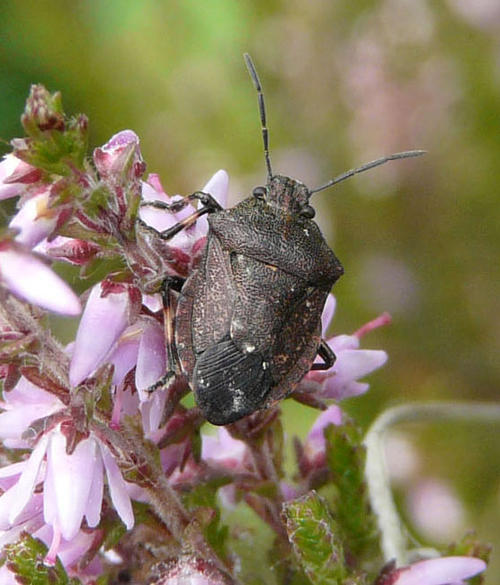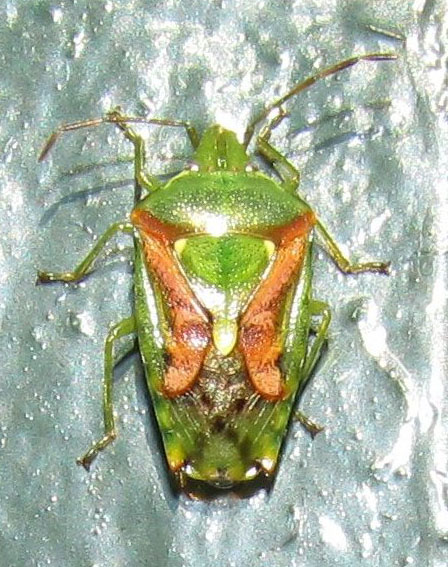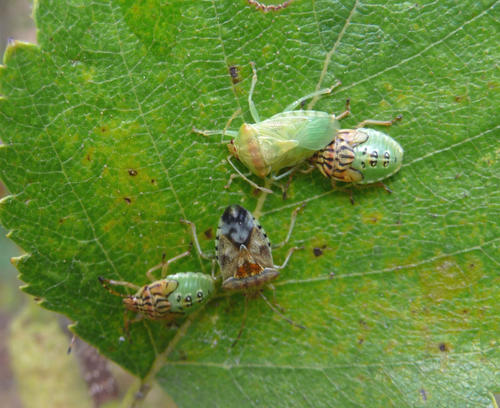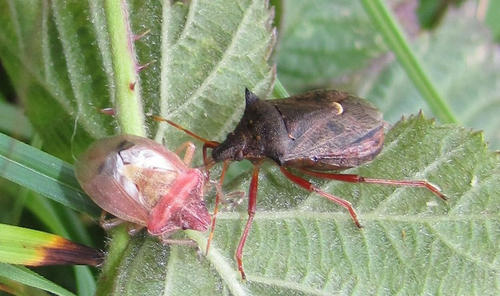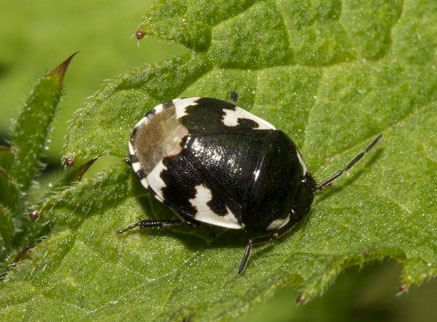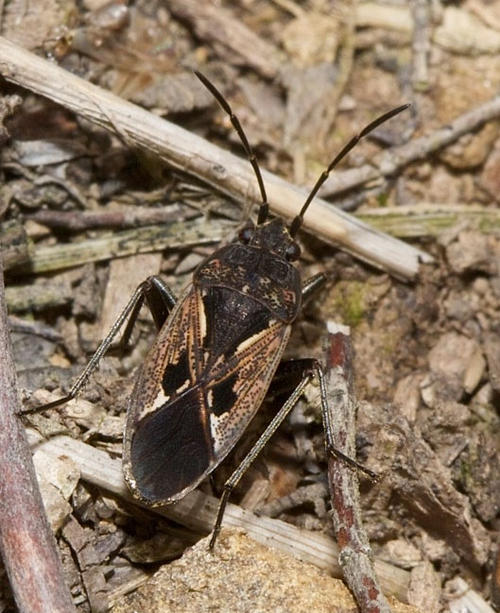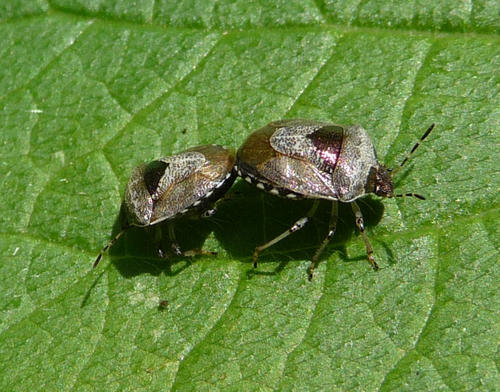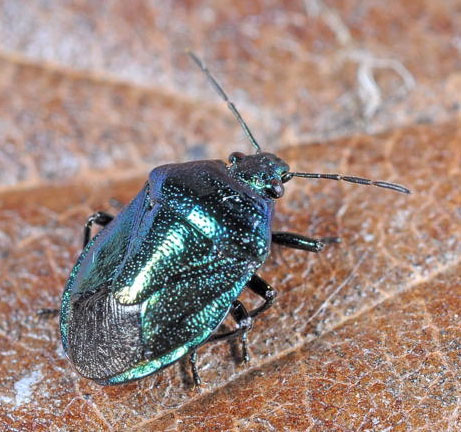Notes on plant bugs (Heteroptera) in Worcestershire
| Harry Green | Introduction |
| Brett Westwood | Fallen’s Leatherbug Arenocris falleni in Worcester |
| Brett Westwood | Masked Hunter on the hearth Reduvius personatus |
| Jane Scott | Interesting Bugs at Woodbank, Astley Burf 2011 |
| Jane Scott | Forget-me-not Bug - Sehirus luctuosus |
| John Bingham | Trapezonotus (Trapezonotus) arenarius (L, 1758). (Lygaeidae) (Heteroptera) |
| John Bingham | Dicranocephalus medius (Mulsant & Rey, 1870) (Hemiptera) Status: Nb |
| John Bingham | Short notes on some Hemiptera found near Kidderminster |
| Harry Green | Corizus hyoscyami, a striking red and black bug |
| Harry Green | Brassica Bug Eurydema oleracea at Upper Blackstone Farm, Bewdley |
| various | Picture gallery |
Introduction
Harry Green
Since John Partridge’s (2004) review of the records of bugs (Hemiptera: Heteroptera) for Worcestershire followed by further encouragement in 2006 more people have taken an interest in the group aided by the excellent British Bugs website (http://www.britishbugs.org.uk ) and several books, notably Evans & Edmondson (2005), Hawkins (2003) and the re-issue of Southwood & Leston’s (1959) classic in 2005 as a paperback far less costly than the scarce original. John also contributed two further reports in 2007 (Pied Shieldbug and a rare bug found in a tussock) and John Meiklejohn (2011) wrote of red and black bugs. There is now also a considerable exchange of pictures taken by digital cameras via email amongst local naturalists which is helping many people to identify bugs and to generate more records.
The classification of True Bugs is complex but clearly set out by Barnard (2011). There is a picture of Pentatoma rufipes, a shieldbug, on the cover.
The range and abundance of several species in the county appear to be changing. John Partridge (2006) wrote of Corizus hyoscyami ‘The bright colouring of this bug should ensure we get more records’. As he predicted this species has become commoner and now often attracts the attention of natural history photographers. On the other hand The Bishops Mitre Aelia acuminate, which became commoner a few years ago, appears to have declined. The Western Conifer Seed Bug Leptoglossus occidentalis, an introduced species from North America, arrived in Worcestershire in 2011 (Holder 2011). The Box Bug Gonocerus acuteangulatus (Curran 2011) has been found in Edgbaston, Birmingham, and can be expected to arrive in Worcestershire before long. The Cow-wheat Bug Adomerus(Sehirus) biguttatus has been rediscovered at Monkwood and from this stimulus was searched for and found in Wyre Forest (Green 2011).
The following compilation (in no particular order) of notes from several active bug-watchers highlights some recent discoveries. There are also pictures of commoner species. Hopefully more people will now be encouraged to study and record bugs. They are an interesting and sometimes colourful group.
This compilation does not attempt cover all the bugs recorded in Worcestershire.
Fallen’s Leatherbug Arenocris falleni in Worcester
Brett Westwood
On August 10th 2011 a posse of naturalists visited Cherry Orchard on the east bank of the Severn south of Diglis in Worcester. The site is managed mainly by Worcester City Council and has a range of habitats including scrub, grassland and riverbank, but the main focus of the day was the area of river sand dredged from the Severn several years ago and dumped to create a substantial ‘dune’. While the conchologists sifted it for the remains of aquatic molluscs, some of us searched the bare sand for invertebrates. It was good to see the sand-loving, ginger-socked solitary bee Dasypoda hirtipes and the red-and black bug, Corizus hyoscyami consolidating their positions in Worcestershire, but my curiosity was drawn to some mottled greyish-brown squash-bugs hiding underneath the mats of fruiting Stork’s-bill Erodium cicutarium on the bare sand. They were beautifully camouflaged against the sand, but I had never seen anything like them before. On consulting Evans and Edmondson (2005) it was clear from photographs and description that these were Fallen’s Leatherbugs Arenocoris falleni which can be distinguished from similar species by the V-shaped cluster of spines on the pronotum. There are also no spines near the apex of the rear femur and the foodplant, Stork’s-bill, is an important clue to identification. Fallen’s Leatherbug is supposed to be coastal in distribution from Norfolk around the English and Welsh south coasts, but records inland are scarce and this appears to be the first record for Worcestershire VC37. How the bugs found this remote site we may never know, but this bug is worth searching for in other sandy places where Stork’s-bill grows.
Masked Hunter on the hearth Reduvius personatus Brett Westwood
Brett Westwood
On the evening of August 16th 2011 I was watching television in the living room of my house in Stourbridge, when from the corner of my eye I noticed a dark shape moving in a sinister fashion across the stone fireplace. Instead of the expected Tegenaria spider, this turned out to be a flattish primeval-looking creature completely covered in dust and sand grains. The camouflage was so complete that it was obviously no accident. A vague memory stirred of bug nymphs which do this, and after a short search, I was able to confirm the beast as Reduvius personatus, the Masked Hunter. This is a large predatory reduviid bug which generally lives in human habitation and feeds on silverfish, flies, harvestmen and, alarmingly, on bedbugs, though there is no evidence of the last in the house. Adults are black and can fly well, hence their other name of Flybugs, but the nymphs are wingless and cover themselves with granules of sand, mortar and dust, applying a new coating after each moult. They live for several months, stalking their prey under this camouflage. In the USA studies have revealed that they can over-winter twice in this nymphal state. The adults and nymphs can pierce human skin with their mouthparts.
It seems that though this bug was once relatively frequent in dwelling houses they are now scarce and Worcestershire Biological Records Centre (WBRC) has only eleven records, with only one other in the north of the county at Chaddesley Corbett. Jane Scott (pers.comm.) also confirms that she has recorded the adults at Astley Burf near Stourport-on-Severn, so it may simply be overlooked or perhaps under-recorded.
Interesting Bugs at Woodbank, Astley Burf 2011
Jane Scott
2011 proved to be a very interesting year, with two new species recorded and several records for a third species, which I had only seen very occasionally in the last few years.
Ceraleptus lividus – first individual was seen on 19th April having presumably overwintered as an adult, with two further individuals seen much later in the year, on 5th September and 6th October respectively. This species seems to be found in warm, dry situations, where the nymph feeds on various leguminous plants, many of which we have in the wilder parts of the garden.
Stictopleurus punctatonervosus – first one found on catmint on 17th October. This one had a damaged wing case whereas the second one, found two days later on lavender, was in good condition. A third was seen on 9th November, also on lavender. Care with identification is needed as this species can easily be confused with a closely related species Stictopleurus abutilon. It is suggested that both these species have a preference for plants in the Compositae family.
There are good images of all these species on British Bugs website, which was of particular help in distinguishing between the two Stictopleurus species. Stictopleurus abutilon is also illustrated by Kevin McGee(2007, 2009) http://www.wbrc.org.uk/WORCRECD/Issue/2027/uncommon_insects_mill_meadow.htm and http://www.wbrc.org.uk/WORCRECD/Issue/2023/records_of_note_2007.htm
Thanks go to Rosemary Winnall who spent time getting some excellent images of my specimens and to John Meiklejohn for his confirmation of my identification.
The third bug which made its presence felt in the garden was Corizus hyoscyami, a black and red bug that has expanded its range in the past few years. I recorded this several times in the garden between 13th July and 28th August, with three individuals seen at the same time on 22nd July. They seemed particularly attracted to lavender, but it may be that they are just easier to spot thereon, although I did also find one on the flowers of Rudbeckia.
We (Dave & Jane Scott) also recorded Corizus hyoscyami species from the following sites:
Longdon Orchard in Wyre Forest – Found under reptile refugia on 20th April. This specimen was very pale and lacked the bright red colouration, presumably as it had overwintered.
Deasland Farm, Nr Bewdley – One found on the flowerhead of ragwort on 3rd August.
Monkwood Reserve near Grimley – One seen on Bramble along main ride on 25th October
No doubt the warm, dry, late summer and autumn proved very beneficial for these insects, so it will be very exciting to see whether any of them make further appearances in 2012.
Forget-me-not Bug - Sehirus luctuosus
Jane Scott
For a number of years now I’ve been regularly seeing this small shiny black shieldbug in my garden in Astley Burf and had rather assumed this to be common in Worcestershire in suitable habitat. After chatting to fellow recorders, it became obvious that very few of them had ever seen this bug, a fact confirmed by the few records received at Worcestershire Biological Records Centre since the year 2000. There have been only fourteen records, seven of which were provided by Kevin McGee (2007) and with one exception, his were from the area around Drakes Broughton where he lived.
In my experience, the adult is most easily seen from the beginning of April until the end of July, with nymphs seen from mid June. They use warm dry situations with a plentiful supply of their foodplant, which not surprisingly is Forget-me-not species. I almost always see them on the ground below the Forget-me-nots Myosotis sp., either amongst the leaf debris or on bare soil. Rarely do I find them on the plants themselves. When disturbed they move very fast and will quickly disappear under the leaf litter or below the surface of the soil. Most are in the ‘gardened’ area but I also find them occasionally in the wilder, south facing area behind the house, which is a mixture of woodland and acid grassland.
I have singularly failed to get a good shot of the adult, but luckily I was able to get one or two pictures of a nymph found wandering about on a path in the garden. I’m hoping that 2012 will be the year that I finally manage to get a reasonable photograph of an adult.
I hope this short article will encourage others to have a good look around any Forget-me-nots in their own garden, or if they haven’t got this plant, to maybe consider introducing it by collecting some seed and scattering it in a suitable place in their plot. As long as you leave some to seed at the end of the season, they will self perpetuate freely.
Strangely, I have never found the bug in the wild, but have to admit to never having seriously searched for it. I hope to remedy this omission in the coming 2012 season.
Trapezonotus (Trapezonotus) arenarius (L, 1758). (Lygaeidae) (Heteroptera)
John Bingham
This ground bug is very similar to others in the general group but can be differentiated by the thin marginal strip to the pronotum with the mid and hind tibiae usually black. British Bugs website is helpful in sorting out the various species. (Bantock & Botting). So far no other Trapezontus species has been found in Worcestershire (as yet!). Southwood & Leston (1959) states they overwinter in adult stage and mate May and June after which they die with a new generation appearing as adult by August. Their habitat is varied but usually has dry soils such as heaths, light sandy soils and dry woodlands.
There are three records on NBN Gateway for Worcestershire:
Recorders day Grafton Wood WBRC recording day 11th July 1998.
One collected from sandy ground at Cherry Orchard, Worcester on 3rd August 2005 by K McGee, confirmed by P.F. Whitehead.
Recorders Day, Lodge Farm, Wyre Forest SO6365 on 10th June 2006, K McGee.
Also found in 2011 on the Recorders Day at Wilden Marsh on 6th August 2011 on sandy grassland SO8273. This last record is where I photographed it on acid grassland typical of those found around Kidderminster in an area of short turf with bare ground heavily grazed by rabbits.
It is not a particularly rare species and is widely distributed over England but there are only very scattered records. It is nearly absent from the south coast. It may be much commoner in Worcestershire than records suggest on any light, dry soil.
Dicranocephalus medius (Mulsant & Rey, 1870) (Hemiptera) Status: Nb
John Bingham
Somewhat surprisingly this is a very scarce species in the Midlands although the main food plant, Wood Spurge, is common. There are only two local records on NBN Gateway:
Wyre Forest.
Haugh Wood, Herefordshire.
It is on the County list for Worcestershire (Partridge 2004).
This species feeds on wood spurge Euphorbia amygdaloides, generally in open sheltered situations within woodlands. It can be found on the plant but it is well hidden. Observed mating on Wood Spurge in Wyre Forest on 26th May 2007. More often it occurs near to the food plant on the ground, typically amongst fairly open vegetation or on bare ground such as recently coppiced plots or areas of conifer clear-fell where there is a flush of wood spurge plants. Most record dates are in late May or early June in the Wyre Forest. Records from Surrey were made on 17th June (Hawkins 2003). Adults overwinter and then mate in May, the new generation appearing from August onwards (Bantock & Botting http://www.britishbugs.org.uk).
Despite the abundance of wood spurge in many Worcestershire woods there appear to be no records of Dicranocephalus medius except from Wyre Forest. It may need large areas of ancient semi-natural woodland to survive and presumably a good supply of wood spurge. As yet I personally have yet to see it on the Worcestershire side of the forest although it must be present? Despite the abundance of the food plant in Wyre, especially in recent years with ongoing coppice and conifer clearance, I have only managed to record it from three locations. It is elusive to say the least!
It should benefit from ride management to maintain open sunny conditions typical for many butterflies, or a good structured wood edge habitat or open glade situation.
Short notes on some Hemiptera found near Kidderminster
John Bingham
Eurydema oleracea found in a cleared conifer plot with regenerating birch woodland on hedge garlic [garlic mustard, Jack-by-the-hedge] Alliaria petiolata, Wyre Forest at Bell Coppice, Shropshire. This was the first record for the county 22nd May 2007. I’ve not seen this on the Worcestershire side of Wyre.
Zicrona caerulea found along a ride at Birchen Park just north of Wyre Forest, only scattered records for Shropshire, found 22nd March 2011.
Dicyphus epilobi found in garden at Kidderminster on Christmas day 2011, a very late date so presumably overwinters.
Nabis ferus found in my Kidderminster garden on low herbage on 11th September 2011.
Rhabdomiris striatellus said to be associated with oak so would expect this to be common in Wyre Forest – found on 17th June 2011 along the disused railway line Worcestershire part of the Forest.
Rhyparochromus pini a southern species associated with heather found on 4th May 2011 at Longdon Wood, Shropshire, on a forest ride and on bare ground created by heathland restoration at Pound Green Common , Worcestershire on 10th September 2011.
Aelia acuminata turned up for the first time in my garden at Kidderminster on 10th September 2011.
Eurygaster testudinaria found in herb rich vegetation near Dowles Brook, Wimperhill Wood, Shropshire. The first time I have recorded this species in Wyre Forest, 10th July 2011.
Aneurus laevis often found under the bark of fruit or hawthorn trees, but any tree might do, scattered over Wyre Forest, 30th September 2010.
Corizus hyoscyami, a striking red and black bug
Harry Green
Corizus hyoscyami does not appear in the list of county records given by John Partridge (2004). Three records are mentioned by him in 2006 but the total had only reached five when John Meiklejohn (2011) wrote about red and black bugs in Worcestershire. His summary was of records received by 2010; additional records for 2010 arrived at the WBRC in 2011. However, 2011 itself was a bumper year for the species in Worcestershire with records from all over the county. Most bug-watchers found them and further records came in via the Worcestershire Wildlife Trust’s Facebook or Blog pages. The bugs were often seen on flowers, especially several species of thistles, and attracted the attention of photographers.
It is worth noting that British Bugs website reports another bug of somewhat similar appearance: Arocatus longiceps (Family: Lygaeidae). To quote the site: ‘This red and black bug is distinctive, although be sure to rule out the rhopalid Corizus hyoscyami. A recent immigrant to the UK, first noted in 2007 and by the end of this year extremely abundant on plane trees in parts of London. This species has recently expanded its range across Europe from the eastern Mediterranean. Initially thought to be Arocatus roeselii, the bug was found in profusion in the grounds of the Natural History Museum, prompting widespread news coverage. It feeds on the seeds of Plane, producing several generations before overwintering communally under bark. Flies readily in warm conditions, when the orange abdomen is conspicuous. Adult found all year, Length 6-7 mm’. This is perhaps one to arrive in Worcestershire in the future.
Corizus hyoscyami is distinctly hairy (well-shown in Pete Smith’s picture) which distinguishes it from similar-looking species.
Brassica Bug Eurydema oleracea at Upper Blackstone Farm, Bewdley
Harry Green
On 6th July 2011 I swept one Eurydema oleracea from mixed ‘arable weed’ vegetation within an arable field at Upper Blackstone Farm owned by Worcestershire Wildlife Trust. This is a scarce species of southern England reaching as far north at Gloucestershire (Evans & Edmondson 2005) although the more up-to-date British Bugs web site states ‘Well distributed in southern and central England’. As mentioned by John Meiklejohn (2011) there are two earlier Worcestershire records made by Kevin McGee (2007) and John Partridge but apparently none since in Worcestershire. John Bingham mentions elsewhere in these notes ‘found in a cleared conifer plot with regenerating birch woodland on hedge garlic Alliaria petiolata, Wyre Forest at Bell Coppice, Shropshire, 22nd May 2007. Not seen in the Worcestershire side of Wyre Forest’.
The species is found on a wide range Brassicaceae including Garlic Mustard Alliaria petiolata and Horse-radish Armoracia rusticana. Kevin McGee’s 2007 records were of bugs found on oilseed rape flowers.
These records suggest that the species may be extending its range northwards so it is worth searching for and obtaining records to check progress, if any.
The species can be as pest of brassica crops in Russia and possibly elsewhere according to http://www.agroatlas.ru/en/content/pests/Eurydema_oleracea/ attacking your plants.
The Brassica bug occurs in a variety of colour forms
Picture gallery
The following pictures show a range of bugs found in Worcestershire. Many are common, a few less so. Some species have a variety of colour forms as illustrated by the Tortoise Shieldbug Eurygaster testudinaria.
The Sloe Bug Dolycoris baccarum and Green Shieldbug Palomena prasina are widespread and common. The larvae of Gorse Bug Piezodorus lituratus feed on the seed pods of gorse and related Genisteae. Has been found on laburnum. The only record from my garden in Little Comberton was of one on a defunct nest of the wasp Dolichovespula media in a laburnum tree! (Green – personal observation)
Green shield bug Palomena prasina is common. The overwintering adults are much darker in colour.
Tortoise Shieldbug Eurygaster testudinaria is widespread in damp grasslands, often within woodland. The larvae feed on rushes.
Heather Bug Rhacognathuspunctatus is found on heathy vegetation, usually in damper areas. The larva is predatory on the Heather beetle Lochmaea suturalis and other beetles.
Juniper Shieldbug Cyphostethus tristriatus, once dependent on juniper berries, is now found on Lawson’s Cypress Chamaecyparis lawsoniana It appears to be extending its range and is widespread in midland and southern England.
The Parent Bug Elasmucha grisea is so-named because the female guards her eggs and young. Both are found in clusters on birch leaves.
Picromerus bidens is a predator of Lepidopteran larvae and other insects, sucking their juices rather than those of plants.
A ground species which climbs White Deadnettle Lamium album and other Lamiaceae. The female cares for her young laying eggs on the ground.
Rhyparochromus pini Although found widely in southern England, south and mid Wales, this is a scarce bug with a scattered distribution. found on heathland or similar habitats often under heather or in leaf litter.
The Woundwort Bug Eysarcoris fabricii is common and widespread in southern and midland England. It forms colonies on Hedge Woundwort Stachys sylvatica.
The Blue Bug Zicrona caerulea is widespread and is a predator leaf beetle(Chysomelidae)and lepidopetran larvae
References
Barnard, P. C. 2011. The Royal Entomological Society book of British Insects. Wiley-Blackwell.
Curran, A. 2011. Box bug Gonocerus acuteangulatus in Edgbaston. Worcestershire Record 30:23.
Evans, M. & Edmondson, R. 2005. A photographic guide to the Shieldbugs and Squashbugs of the British Isles. WGUK in association with WildGuide UK.
Green. H. 2011. Adomerus biguttatus (=Sehirus biguttatus), the Cow-wheat Shieldbug re-found in Worcestershire. Worcestershire Record 30:22.
Hawkins, R. D. 2003. Shieldbugs of Surrey. Surrey Wildlife Trust, Woking.
Holder, J. 2011. Western Conifer Seed Bug Leptoglossus occidentalis in Droitwich. Worcestershire Record 31:21
McGee, K. 2007. Records of note 2006. Worcestershire Record 21:29-33.
McGee, K. 2007. Records of note 2007. Worcestershire Record 23:42-46
McGee, K. 2009. An account of uncommon insects I have recorded at the Mill meadow/Mill Rough complex since 1996. Worcestershire Record 27:7-12
Meiklejohn, J.W. 2003. The squash bug Coreus marginata in Worcestershire. Worcestershire Record 14:34.
Meiklejohn, J.W. 2011. Red and black bugs (Hemiptera –Heteroptera) in Worcestershire. Worcestershire Record 30:23-24.
Partridge, J. 2004. Shieldbugs of Worcestershire. Worcestershire Record 17:31-34
Partridge, J. 2006. Hemiptera records for Worcestershire. Worcestershire Record 21:41
Partridge, J. 2007. A rare bug in a tussock [Lasiosomus enervis]. Worcestershire Record 20:3
Partridge, J. 2007. The Pied Shieldbug Sehirus bicolor. Worcestershire Record 22:26
Southwood, T.R.E, & Leston,D. 1959. Land and Water Bugs of the British Isles. Warne.
Southwood, T.R.E. & Leston, D. 2005. Land and Water Bugs of the British Isles. A reprinted version by Pisces Conservation Ltd.
Web sites
Bantock, T. & Botting, J. 2010. British Bugs website: http://www.britishbugs.org.uk/ accessed April 2012.
http://www.agroatlas.ru/en/content/pests/Eurydema_oleracea/ accessed July 2011.
Images
Fig. 01. Fallen’s Leatherbug Arenocris fallen. Brett Westwood.
Fig. 02. Fallen’s Leatherbug Arenocris fallen. Harry Green
Fig. 03. Masked Hunter Reduvius personatus. Brett Westwood
Fig. 04. Ceraleptus lividus Rosemary Winnall
Fig. 05. Stictopleurus punctatonervosus. Rosemary Winnall
Fig. 06. Stictopleurus punctatonervosus. Rosemary Winnall
Fig. 07. Forget-me-not Bug nymph Sehirus luctuosus. Jane Scott
Fig. 08. Forget-me-not Bug Sehirus luctuosus adult. Kevin McGee
Fig. 09. Trapezonotus (Trapezonotus) arenarius. John Bingham
Fig. 10. Dicranocephalus medius. John Bingham
Fig. 11. Dicranocephalus medius. John Bingham
Fig. 12. Corizus hyoscyami. Pete Smith
Fig. 13. Corizus hyoscyami. Note the hairs. Pete Smith
Fig. 14. Brassica Bug Eurydema oleracea with reddish markings. John Bingham
Fig. 15. Brassica Bug Eurydema oleracea with pale yellow markings. Harry Green
Fig. 16. Sloe Bug Dolycoris baccarum, Gorse Bug Piezodorus lituratus, and Green Shieldbug Palomena prasina. Jane Scott
Fig. 17. Green shield bug Palomena prasina. Harry Green
Fig. 18. Tortoise Shieldbug Eurygaster testudinaria. Harry Green
Fig. 19. Tortoise Shieldbug Eurygaster testudinaria. Harry Green
Fig. 20. Heather Bug Rhacognathus punctatus. Brett Westwood
Fig. 21. Juniper Shieldbug Cyphostethus tristriatus. Gary Farmer
Fig. 22. Parent Bug Elasmucha grisea final instar larvae and some newly moulted into adults. Harry Green
Fig. 23. Picromerus bidens feeding on Eurygaster testudinaria. Gary Farmer.
Fig. 24. Pied Shieldbug Tritomegas bicolour. Harry Green
Fig. 25. Rhyparochromus pini. Brett Westwood
Fig. 26. Woundwort bug Eysarcoris fabricii. Harry Green
Fig. 27. Blue Bug Zicrona caerulea. John Bingham
